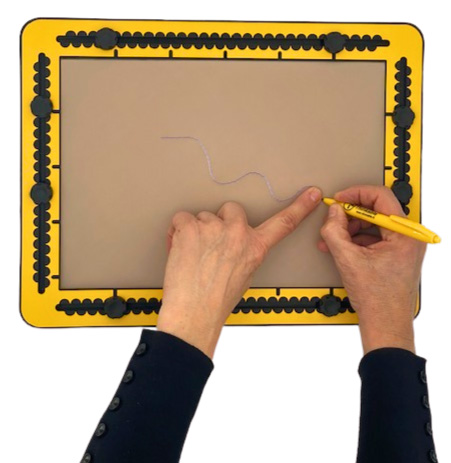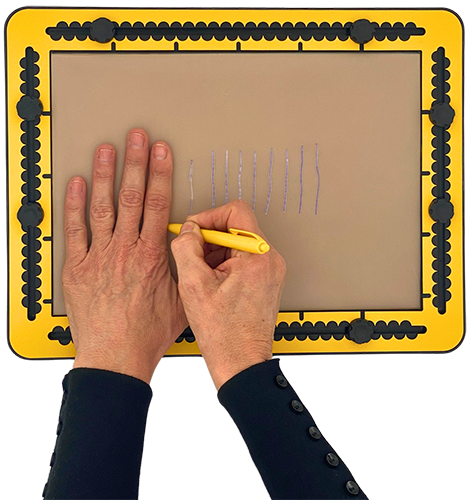Speed of drawing and accuracy
Your both hands and fingers are the core of the tool set to create raised line drawings. For the TactiPad, they need to be extended with additional tools such as a pen, a ruler, compass and many others. Probably they will execute new gestures and movements. So, it might well be that you / your hands and fingers can benefit from some training in order to perform the drawing tasks as best as possible. The definition of ‘best’ is open for discussion, but aspects like speed, fluency and accuracy are certainly part of this.
In this text you find instructions and exercises to become ‘better’ in free hand drawing. In the section ’measuring and drawing with a tool’ you find additional information to develop various drawing strategies. With these two sections we would like you to get to the point where you just grasp the pen and draw the subject of interest, without having to think on the ‘how to’ part.
Pen position
It is not easy to describe the ideal position on how to hold the pen in your hand. Here is an attempt, where it is assumed the pen is in your right hand. Take the pen in your right hand with the tip away from the hand. Bring the thumb, pointing finger and middle finger of your left hand loosely together so they form a triangle. Stich the pentip into this triangle for about 1,5 to 2 centimetres. Your fingers will move away from each other.
Now place your thumb and pointing finger of your right hand against the tips of the left hand fingers. As by nature , the middle finger will also go to the pen. Now the tip of the pointing finger and the area near the first joint of the thumb hold the pen whereas the middle finger presses from the side against the pen. The pen is inside the three fingers of the right hand with the pen tip pointing left. The middle finger supports the body of the pen. In fact the thumb presses the pen against the finger. This resting position can vary due to personal preference, but near to the nucle seems like a good position.
Alternatively you can hold the pen in your fist, but it is harder to control the precision in your drawing because the movements come from your wrist and/or elbow.
Exercise: Drop the pen on the table and pick it up as fast as possible. Follow the above instructions to position the pen in your hand. Place the pen tip on the drawing area. Repeat the steps 50 times.
Positioning your hand on the drawing board
When the pen is in your hand you can role the hand off to the right. The right part of your wrist is now on the drawing board surface. The bone that is present here is a perfect support and turning point; the hand can swing and the fingers can move in and out. The combination of these two movements offer space for detailed drawing actions. See also basic shapes. Larger movements origin from the elbow and/or shoulder.
Exercise: Put your wrist on the drawing board and investigate which area you can cover with your hand and fingers while keeping the wrist at the same position. Use your left hand to get a feel for the distances.
Pressing on the paper; how much force
When holding the pen as described above, you can start drawing. Start somewhere near the top left corner so there is enough paper for the first exercises. Place the pen on the paper. The pen is in fact leaning over in the direction of your hand. Place your pointing finger of your left hand against the pen tip. Press down and drag the pen towards you. Your left hand pointing finger should now discover a raised line! This pulling operation is the most easiest one.
Exercise: At this point you may test a few times how much force you need to apply to get the effect. Also, a different force results in different heights.
Please note, the lines that you get are not really soft. The paper has a miniature weaver pattern that creates the raised line effect. When looking into the details, the line is not fully smooth. At first touch however it is a solid line.
Your name in large characters
When you know the shape of the characters of your name, it is funny and good exercise to write it a few times down. Make sure the characters are at least two centimetres (approx 1 inch) high or more. Writing your name forces moving the pen in different directions and simultaneously keeping an equal force to maintain the height of the lines. Now pull and push operations are alternated.
Basic shapes
Time to move on to the next exercise; creating basic shapes that you need quite often. Exercise: Lean with the side of the wrist on the drawing board and draw the shapes with a size of 2,5 centimetres (approx 1 inch). Do not move with your arm while drawing one of the following shapes:
- Short line
- (Equilateral) Triangle
- Square
- Circle
- Ellipse
You will experience an increased difficulty in this list. The images may be positioned next to each other or even partly overlap.
Drawing straight lines
The definition for a line is the shortest way between two points, but how to get this right? For short lines up to 5 centimetres (approx 2 inch) this can be done while keeping the hand in the same position.
Using your finger as ruler. For a little longer line you could drag the pen alongside your finger. Just try this and you will be amazed how well this goes. Generally speaking it is recommended to keep the hand that is not holding the pen on the drawing board as well. At least when you are not using a tool.
Draw a line with a length of 10 centimetres (approx. 4 inch) between two finger tips is now possible. Find the begin and end position and place your thumb and pointing finger respectively. Determine based on your previous experience the direction on where to start the line (pulling or pushing the pen). For this distance the hand has to rotate together with the fingers that hold the pen. Use the, for you, highest speed to move the pen to keep the line straight. Lines of higher length require a tool like a ruler. However, in case they don’t need high accuracy, you can draw them with high speed, also moving your elbow.


